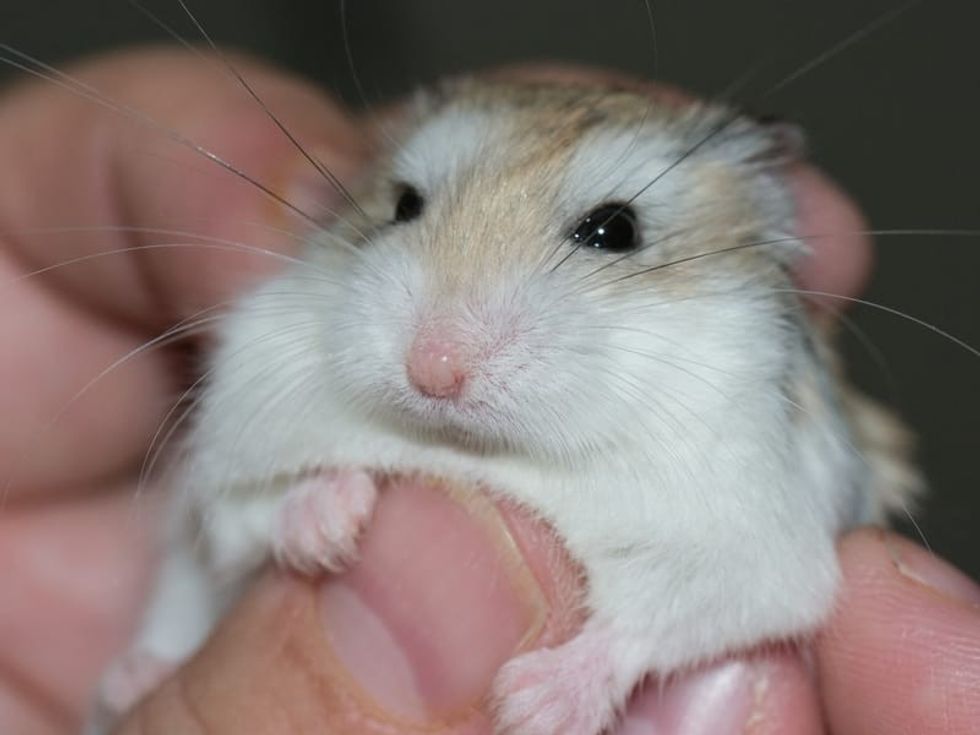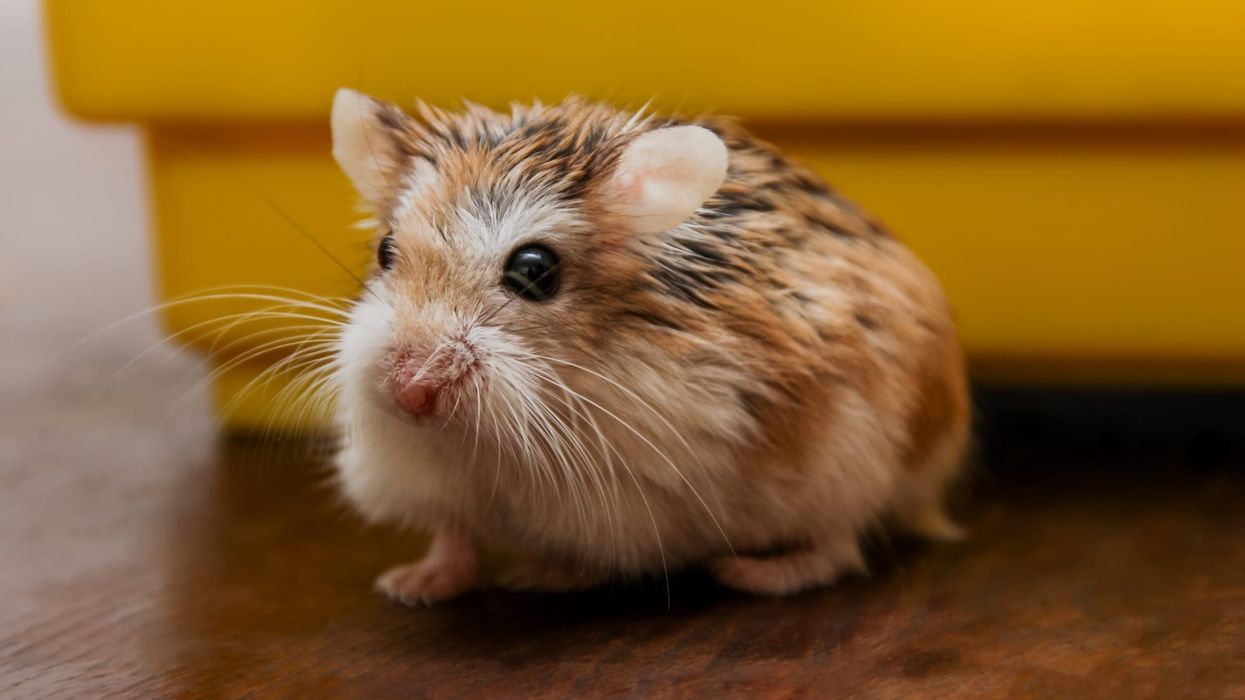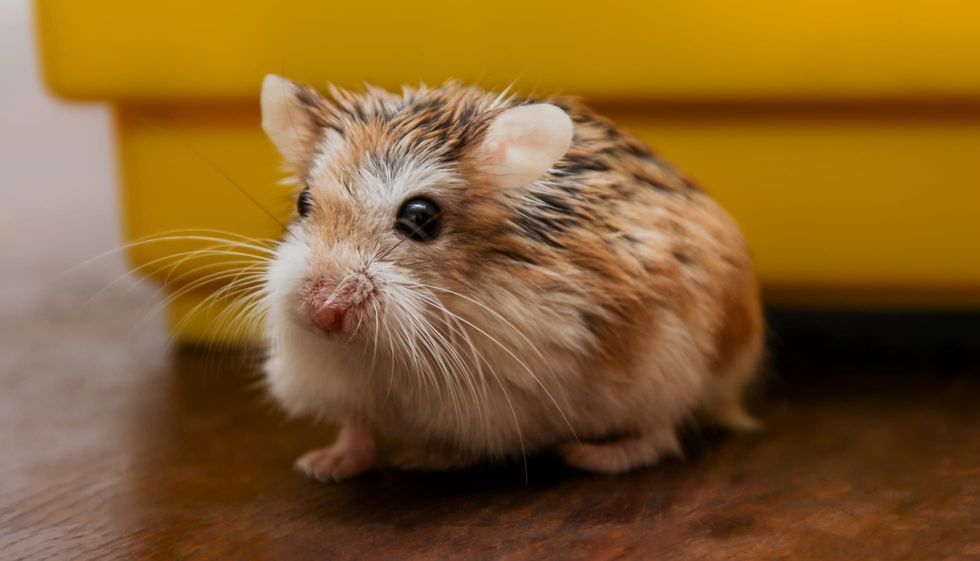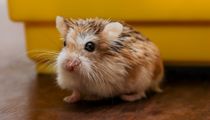Fun Roborovski Dwarf Hamster Facts For Kids

Content
- What type of animal is a Roborovski Dwarf hamster?
- What class of animal does a Roborovski Dwarf hamster belong to?
- How many Roborovski Dwarf hamsters are there in the world?
- Where does a Roborovski Dwarf hamster live?
- What is a Roborovski Dwarf hamster's habitat?
- Who do Roborovski Dwarf hamsters live with?
- How long does a Roborovski Dwarf hamster live?
- How do they reproduce?
- What is their conservation status?
- What do Roborovski Dwarf hamsters look like?
- How cute are they?
- How do they communicate?
- How big is a Roborovski Dwarf hamster?
- How fast can a Roborovski Dwarf hamster run?
- How much does a Roborovski Dwarf hamster weigh?
- What are their male and female names of the species?
- What would you call a baby Roborovski Dwarf hamster?
- What do they eat?
- Are they big eaters?
- Would they make a good pet?
- Did you know...
- How to grab Roborovski Dwarf hamster in your hands?
- How to tell the age of a Roborovski Dwarf hamster?
Looking for the cutest, absolute babies in terms of hamsters? Then you have come to the right place - to the Roborovski Dwarf Hamster facts!
They can be a wonderful pet for you, but it is advised you do your research before you adopting one or attempting breeding them. If you are looking for less care-intensive pets, then you may not want to look after them.
Though these adorable hamsters are native to South China, Central Asia, Kazakhstan, Mongolia, and more, we can get one anywhere across the world thanks to breeding facilities and human intervention.
These hamsters are now owned and loved as a family pet by many people - though it is not advised that they be kept by families with children, other pets, or even other hamsters.
They are small, delicate, and are best suited to quiet homes with responsible adults as owners.
When not in your home as an adorable pet, these hamsters can be seen zooming across deserts in the night foraging for food, before returning to their burrowing as soon as the first ray of sun hits the horizon.
Be they in the wild or in a cage back home, the hamsters continue to look adorable, are forever speedy and sociable, and would love nothing more than to run on the wheel forever!
Intrigued? Read on to discover all there is to know about this cute and unique hamster.
If you enjoy reading about this hamster, or hamsters in general, then do check out dormouse and naked mole-rat facts as well.
Roborovski Dwarf Hamster Interesting Facts
What type of animal is a Roborovski Dwarf hamster?
The Roborovski Hamsters are a type of hamster. Hamsters belong to the larger species of rats and mice, but this is not any ordinary type of hamster. It is the smallest type of hamster in the world!
What class of animal does a Roborovski Dwarf hamster belong to?
The Roborovski Hamsters belong to the mammal class. This means that they give birth to live children as opposed to laying eggs.
How many Roborovski Dwarf hamsters are there in the world?
Due to lack of research, there is no particular number on the population of the Roborovski Hamsters. However, scientists are not concerned about the population of this hamster for two reasons.
One, that they are very prolific breeders themselves, breeding multiple times in the same year, which keeps their population high. The second reason is that due to their involvement in the pet trade across the world, breeders are also invested in keeping their population stable.
Where does a Roborovski Dwarf hamster live?
The Roborovski Hamsters are found living in Asian deserts and dry land - particularly South China, Mongolia, and Kazakhstan.
In captivity, the Dwarf Hamster lives in a cage like a pet, without having to forage for food, and are able to live out its summer months in the comfort of a cage. In the wild, however, they live in burrows that can go down to six feet.
This allows them to stay cool, hide from predators, and sleep off the hot summer days because too much sun is harmful to them.
What is a Roborovski Dwarf hamster's habitat?
Roborovski Hamsters prefer living in the deserts. They live in places with loose sand, little vegetation, and no water around.
As such, they are usually seen living in holes up to six feet deep and emerge outside only during dawn or dusk. These hamsters are nocturnal creatures, meaning they only look for food, move, and interact at night, and spend their hot days sleeping.
Since they are found in the desert, your favorite pet hamster is also called the Desert Hamster.
Who do Roborovski Dwarf hamsters live with?
The Roborovski Hamsters are found alone. They are solitary animals, and will not be seen in small groups and pairs.
However, when the breeding season is on, they will come together, usually in different sex pairs or one female against multiple males, and they will breed. The females expect a litter in 22 days or so, with the litter being around six in number.
How long does a Roborovski Dwarf hamster live?
The Roborovski Dwarf Hamster lifespan is two to four years, depending on whether they are in captivity or in the wild. Unlike many other hamsters, this hamster thrives in captivity and has been recorded to thrive for up to four years while in a cage.
This is because they have no natural predators in cages, get ample food and water, and have ideal living conditions.
Provided the human has cared for them well, their lifespan increases dramatically. However, mishandling, or not taking care of your pets well, may result in them developing diseases, and dying prematurely.
How do they reproduce?
The Roborovski Hamsters reproduce by breeding. The gestation period of the species is very short, at less than a month. Their gestation period is around 20-22 days, after which they have a litter, size averaging at six.
These babies are usually kept in the burrows until they are fit to be out in the world under the supervision of their parents. When they are born, they do not have any fur. They first develop their whiskers, then fur, and then other outer coverings.
What is their conservation status?
According to the IUCN Red List, the Roborovski Hamsters are of Least Concern. This is not only just because of their frequent breeding tendencies but also because of human intervention that allows their numbers to be high enough to not be a concern.
Roborovski Dwarf Hamster Fun Facts
What do Roborovski Dwarf hamsters look like?
The Dwarf Hamsters are one of the smallest hamster species around. These little hamsters have a brown overcoat with a white face and underbelly.
This brown shade is sandy on average but can become lighter and darker depending on the variation of the Dwarf Hamster and their physical location, diet, and exposure to the elements. They also have two spots above their eyes that look like eyebrows and mix in with their white face.
They have small, sharp claws, and teeth that never stop growing throughout their life. The Dwarf Hamsters suffer from this condition even as a pet in a cage, and as such, this should be taken care of.

How cute are they?
The Roborovski Hamsters are very very cute indeed! They are not only small but have adorable, big eyes that will definitely charm you.
However, you should take great care in handling them, as they are very delicate - even for a pet in a cage. They were first discovered by Lt. Vsevolod Roborovski in 1894, after who the hamster has been named.
However, he only made a passing note on them, and it was not until the late 1970s that they were formally studied and given a scientific outlook.
Coincidentally, it was also in the 1970s that America had this animal imported from Russia, where it was first introduced in a zoo. Since then, for the longest time, only the wealthy could have this breed as a pet.
Now, however, they have managed to be in every continent, and their prices have fallen dramatically. So for anyone who has fallen in love with this tiny hamster, it's good news!
How do they communicate?
The Roborovski Hamsters have paired flank scent glands, and communicate by scent only. They do not have any vocal cords.
The male tends to have more intense scents when marking territory, whereas the female tends to have more scents when looking to breed in the breeding season. They mark their territory by rubbing themselves against walls, the floor, and other solid surfaces, while the females do this to express their readiness to mate.
They are also very aggressive and may end up attacking, pushing, biting, and nipping at others, including their own mate, or another hamster of the same species. Therefore, it becomes absolutely essential to keep this hamster isolated if kept as pets. If in the wild, they avoid each other naturally.
How big is a Roborovski Dwarf hamster?
The Roborovski Hamster is the smallest species of hamster. This is because they are approximately 4-5 cm long.
That makes them about as big as an adult thumb meaning you can carry them in your palm and they will fit very comfortably there indeed!
However, even if the Dwarf Hamsters have spent their entire lives in a cage as a pet, they will not enjoy being held and handled. Though the wheel provides some modicum of engagement along with other toys in the cage, it is recommended that you let them out of the cage at least once a week.
How fast can a Roborovski Dwarf hamster run?
The Roborovski Hamster is also the fastest of hamsters, though they do not have any speed on record. However, if you want to see them at their top speed, you should know that the Robos are active at dawn and dusk only.
They are also less active in the summer months when they prefer to be their burrows. Even though the Dwarf Hamsters emerge only in certain parts of the day, they manage to run around six miles every single night! Talk about dedication.
How much does a Roborovski Dwarf hamster weigh?
The Roborovski Hamster weighs very little, coming in at around 1-2 g. This is the average for their breed. The female will weigh marginally less than a male due to their smaller size.
What are their male and female names of the species?
The male Roborovski Hamster is called a boar, while the female Roborovski Hamster is called a sow. This language is used for Robo Hamsters as well as the male and female of other species, but if you choose to adopt your own pet, then you do not have to follow this naming.
You can come up with your own unique names for your pets, and they will appreciate you for it.
What would you call a baby Roborovski Dwarf hamster?
The baby Roborovski Hamster is called a pup. When the litter is first born, they are an average of six in number and are always born hairless. As the babies mature into adult males or females, then we see them first developing whiskers, fur, and other external features.
What do they eat?
The Robo Dwarf Hamsters have a very big diet since they burn it all off during activity. Their primary diet is grains, vegetables, and plants.
In the wild, they will occasionally also eat small insects if there is no other food available. This has been the trend observed in the hamsters that live in Mongolia, where vegetation is few and far in between.
In Mongolia, their diet is almost 85% insects, while the rest is taken care of by the sparse vegetation.
While they are kept in a cage as pets, you should take care that their diet consists of high-quality hamster food. If you feed them anything other than what they would normally eat outside in the wild, you risk giving them stomach issues.
Are they big eaters?
You could consider them big eaters, but they eat food in proportion to how much activity they look forward to.
Since the Robo Dwarf Hamsters are extremely active (even when in a cage), they will need to eat accordingly. If you are looking to have Robos as pets, then you can make things simpler and place adequate food in their cage, and simply keep changing it every 24 hours.
Make sure there is ample food, though, because if the Dwarf Hamsters feel that there is not enough food, they will starve themselves of all food, (or eat their young, if there are any).
Would they make a good pet?
If you are new at hamster care, or if you are looking to adopt your first pet, then the Robo Dwarf Hamster is not a good option for you. They are stubborn, timid, very difficult to train, speedy, and prone to biting.
If you do not care for them well, it can result in them breaking a limb, fracture, and even death.
However, if you are an expert handler and have managed to care for multiple hamsters in the past, then the Robo Hamster is a great option for you.
Additionally, due to the delicate nature of this hamster, you should avoid adopting it if you have children, dogs, or any other type of pet at home. Loud noises scare them and will prevent you and your pets from bonding.
Looking after them is a long, complicated process. They need an immense wire cage, to begin with, with two inches of bedding, and 15-20 cm of a substrate to allow for their digging tendencies.
The bedding should not be of any material that can come apart in strands (wool, cotton), but of items that can be torn apart fully, (like toilet paper roll).
In addition, they should also not be kept in direct sunlight and should have plenty of stimulation in the form of a wheel and other exercise equipment. In addition to a wheel, it is also recommended that they be provided with other moving contraptions which help keep your pet entertained long after they arise.
It is highly advised that when preparing for Roborovski Dwarf Hamster care, keep only one in a cage. Robo Hamsters can be kept in same-sex pairs, but only if they are raised together.
Mating pairs also should not be ket together. While they enjoy interacting with their own kind, they are also aggressive and territorial - and often hurt one another. This is especially true once the first litter is born, because parents may occasionally hurt their own babies.
In terms of feeding your Robo Hamsters, it is advised to have food and water readily available, and anything not consumed within 24 hours should be thrown away.
In order to supplement their diet with healthy food, you can feed Robos vegetables, fruits, and occasionally, grain too. You should also let them out of their cages once a week at least, but be careful about it because Robos are very speedy runners.
They may run away from you, and then looking for them might be a complicated process given how small and easily hurt they are.
Overall, a balanced combination of good food, exercise, and clean-ups are enough to keep your Robo Hamster healthy and happy.
Did you know...
Unlike many other hamsters and hamster species, the Dwarf Hamsters have a very unique way of biting. Many other hamsters can be seen nipping their opponents and then backing away, trying to escape.
However, the Roborovski Hamsters bite into their opponent, and cling on, refusing to let go.
This makes them difficult to handle, even as pets, which is why new Roborovski Hamsters' owners are advised to do everything possible not to scare them. If they scare their hamster pets, they will be promptly bitten, and might even have to visit the vet to get their pet off their limb.
This is another reason why it is recommended that they not be adopted as pets if the owners have children or another animal, who will promptly attack back if bit, which will almost certainly result in the death of your hamster.
How to grab Roborovski Dwarf hamster in your hands?
Grabbing dwarf hamsters in your hands can be tricky work. The Robos can be naturally suspicious, timid, and prefer to stay in their wire cage away from human hands.
Since this species of hamsters is also small and delicate, it is important that you do not handle your pet too roughly. The first step is getting the Robos to trust you. You can do this by offering them treats, and waiting for the animal to approach you.
This step will involve a lot of waiting, because, as mentioned before, they will be naturally suspicious of you. Hwever, if you wait long enough, and do not move your hand much, the animal may approach you, sniffing your hand.
At this stage, it is important to ensure that your hands do not have any scent (handwash, soap, perfume) on them because that will scare off your little pet. It is best to have unscented hands as they approach.
If all has gone well, and they continue eating the treats, they will get more comfortable with your hands. Now, you should start shifting the treats further up your hands.
You started at your fingertips, to your fingers, and now your palm. Ensure that this process is gradual and slow, and do not be discouraged if they do not follow through, but try again.
This trust-building exercise may help the hamsters trust you, and soon, start placing the treats in your hand, and wait for them to climb into your hands. As you keep bribing them with these treats and keeping your hand stable, you should be holding a hamster in no time.
You can then gently close your fist around them, and hold them carefully, but ensure that you do not do it for more than a couple minutes.
However, you should pay attention because the Robos are very delicate animals, and should not be roughly grabbed. Even if they trust you, you should not handle your pets in your hand for too long because human touch is extremely rough and harsh for them.
Therefore, unless it is an emergency, it is advised to not hold your pets, and let them run amock in their cages instead.
How to tell the age of a Roborovski Dwarf hamster?
There are three major characteristics you should be keeping an eye out for when trying to check the age of your breed. Mind you, these characteristics are just an estimate, and by no means a scientific method to check for the age of these animals.
The first is their fur and the second one is teeth.
A healthy coat of fur along with regularly growing teeth are all signs of a young hamster. As they age, this breed will start losing hair, have yellow shaded teeth, have patches of fur, and other issues.
The third indicator is their activity levels. This breed is known to be very active, even as babies.
So you will see them constantly running in their wheel, looking for treats, and moving around in general. As they age, this activity slows down, they start developing health issues such as losing sight, exhaustion, and others. You should also keep in mind that three human years are 80 hamster years.
So, every year, your hamster grows to a little under 30 years. When we keep this in mind, it becomes easier to pinpoint the signs of their aging and work accordingly.
Here at Kidadl, we have carefully created lots of interesting family-friendly animal facts for everyone to discover! Learn more about some other mammals including gopher, or porcupine.
You can even occupy yourself at home by drawing one on our Roborovski Dwarf hamster coloring pages.
We Want Your Photos!
More for You
Sources
https://animalia.bio/roborovski-hamster
https://animalcorner.org/animals/roborovski-hamsters/
https://petkeen.com/roborovski-dwarf-hamster/
https://en.wikipedia.org/wiki/Roborovski_dwarf_hamster
See All
Bachelor of Arts specializing in English Language, Master of Philosophy

Devangana RathoreBachelor of Arts specializing in English Language, Master of Philosophy
Devangana is a highly accomplished content writer and a deep thinker with a Master's degree in Philosophy from Trinity College, Dublin. With a wealth of experience in copywriting, she has worked with The Career Coach in Dublin and is constantly looking to enhance her skills through online courses from some of the world's leading universities. Devangana has a strong background in computer science and is also an accomplished editor and social media manager. Her leadership skills were honed during her time as the literacy society president and student president at the University of Delhi.
Bachelor of Technology specializing in Information Technology

Smriti ChaudharyBachelor of Technology specializing in Information Technology
Smriti, a student data scientist, and coder, is pursuing her Bachelor of Technology at K.J. Somaiya College of Engineering. She has achieved top rankings in the International English Olympiad, National Spelling Bee, and PSAT/SAT English Section. She is experienced in content creation and editing for various academic institutions.
Disclaimer
1) Kidadl is independent and to make our service free to you the reader we are supported by advertising. We hope you love our recommendations for products and services! What we suggest is selected independently by the Kidadl team. If you purchase using the Buy Now button we may earn a small commission. This does not influence our choices. Prices are correct and items are available at the time the article was published but we cannot guarantee that on the time of reading. Please note that Kidadl is a participant in the Amazon Services LLC Associates Program, an affiliate advertising program designed to provide a means for sites to earn advertising fees by advertising and linking to Amazon. We also link to other websites, but are not responsible for their content.
2) At Kidadl, we strive to recommend the very best activities and events. We will always aim to give you accurate information at the date of publication - however, information does change, so it’s important you do your own research, double-check and make the decision that is right for your family. We recognise that not all activities and ideas are appropriate for all children and families or in all circumstances. Our recommended activities are based on age but these are a guide. We recommend that these ideas are used as inspiration, that ideas are undertaken with appropriate adult supervision, and that each adult uses their own discretion and knowledge of their children to consider the safety and suitability. Kidadl cannot accept liability for the execution of these ideas, and parental supervision is advised at all times, as safety is paramount. Anyone using the information provided by Kidadl does so at their own risk and we can not accept liability if things go wrong.
3) Because we are an educational resource, we have quotes and facts about a range of historical and modern figures. We do not endorse the actions of or rhetoric of all the people included in these collections, but we think they are important for growing minds to learn about under the guidance of parents or guardians.







